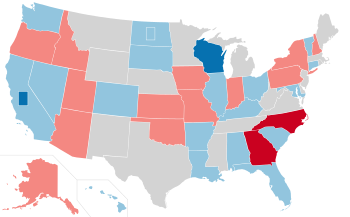| ||||||||||||||||||||||||||||||||||||||||
36 of the 100 seats in the United States Senate 51 seats needed for a majority | ||||||||||||||||||||||||||||||||||||||||
|---|---|---|---|---|---|---|---|---|---|---|---|---|---|---|---|---|---|---|---|---|---|---|---|---|---|---|---|---|---|---|---|---|---|---|---|---|---|---|---|---|
| ||||||||||||||||||||||||||||||||||||||||
 | ||||||||||||||||||||||||||||||||||||||||
| ||||||||||||||||||||||||||||||||||||||||
The 1992 United States Senate elections, held November 3, 1992, were elections for the United States Senate. The 34 seats of Class 3 were contested in regular elections, along with special elections to fill vacancies. They coincided with Bill Clinton's victory in the presidential election. This was the first time since 1956 that the balance of the Senate remained the same.
Both parties swapped a pair of seats, resulting in no net change in the partisan breakdown, which had been at 57–43 since Democrats flipped a seat in Pennsylvania in a special election. Democratic victories over Republicans John F. Seymour in the special California race and Bob Kasten in Wisconsin were canceled out by the defeats of Democrats Wyche Fowler in Georgia and Terry Sanford in North Carolina.
The election of 4 new Democratic women to the Senate was notable with it being referred to in the press as the "Year of the Woman". Due to a special election in California, both of California's Senate seats were up for election in 1992, and these seats were won by Dianne Feinstein and Barbara Boxer. Thus, California became the first state to have elected women to occupy both of its Senate seats. Democrat Carol Moseley Braun of Illinois, became the first African-American woman in the United States Senate. As of 2023[update], this was the last election cycle in which Republicans won a Senate election in New York and Democrats in Kentucky.
Cite error: There are <ref group=lower-alpha> tags or {{efn}} templates on this page, but the references will not show without a {{reflist|group=lower-alpha}} template or {{notelist}} template (see the help page).

